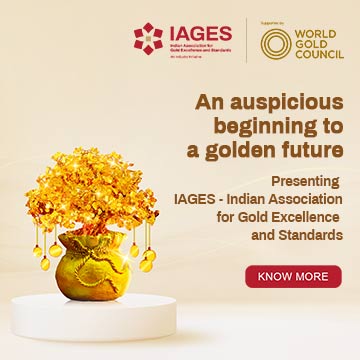There have been major issues threatening the industry’s health. In the first place — and of prime importance — consumer sentiment. A year ago nobody really thought we would take a hit from an upcoming U.S.-China trade war.
The direct issue isn’t the tariffs on Chinese imports but the macro impact of the trade war on American consumer confidence and how that affects diamond purchasing.
It is in this context noteworthy that the shares of Signet, the largest retail chain in the world, showed a tremendous decline in 2019 and was pushed out of the S&P 500. Signet alone still stands for 15% of the entire downstream diamond market in the U.S.
In September there was still a predicted 2-4% growth for the U.S. on par with Japan and lower percentages in Europe due to socio-political unrest in the UK and France. Now, 3 months later, it has become clear from a report published on 11 December by consultancy Bain & Co. that global diamond for jewelry retail sales are expected to fall 3% in USD equivalent.
The decline is presumably driven by changes in the two largest markets, the US and China, where jewelry sales are expected to decline by 3% and 8%, respectively, mainly due to a drop in consumer confidence and geopolitical uncertainties. In the US, a slowdown in Chinese tourism, among other developments, also negatively affected sales.
Hong Kong’s retail sales have suffered a record contraction since October. Retail sales of jewelry, watches, clocks and other valuable gifts by value dropped by 41% in the month of September from a year earlier.
The retail data indicate that the annual “Golden Week” holiday in Mainland China failed to translate into a tourist bump that could have alleviated the domestic economic pain. Overall, visitors to Hong Kong fell by almost 44%.
Cosmetics retailer Sa Sa International Holdings Ltd. is said to close about 30 stores in the coming year. Sa shares have tumbled more than 40% this year. At the same time, the big houses are aggressively shifting their strategic focus to Mainland China.
***
What does this all mean for the midstream?
The situation has led to an insecure market and a pipeline that looks dangerously overstocked. De Beers’ sales are now at their lowest level since 2015, the year of the last crisis. Analyst Paul Zimnisky believes the current funk was in part sparked by the bank scandals in early 2018. Lenders, who were already viewing the industry skeptically, cracked down even harder.
In some cases, in the past year, we saw substantial forced liquidation of inventory. Gems were dumped onto the market at low prices. At the same time, demand was weak in key markets, such as India and China, putting further pressure on polished prices. According to Zimnisky, supply indigestion is currently the biggest challenge for the rough market, as he estimates that as much as $10 billion of excess diamonds have come out of the mid-stream segment over the last year-and-a-half.
Midstream revenues fell as much as 25% in 2019, the Bain & Co. study indicated, as near record-high rough diamond production at the beginning of 2019 was not matched by increasing demand for polished diamonds, leading to higher inventory levels that generated a ripple effect through the supply chain.
Manufacturers have reached the breaking point, and they’ve decided they can’t keep losing money. There’s no sense buying when they are already clogged with an inventory. Indian manufacturers have reduced their rough diamond purchases by about 30% to offload inventory and improve their cash flow.
Once wholesalers, traders, and retailers digest current inventory, at the end of the tunnel, the industry will be much better positioned. According to Bain & Co.’s latest report this week, recovery may take another year.
The impact on rough diamond pricing has been felt across the industry. Smaller miners have fallen to the lowest valuations in years, while dominant producer De Beers has been forced to react. De Beers’ year-to-date revenues have fallen 26% since 2018, due to lower volumes of sales, a weaker product mix, and a softening price index.
As it becomes clear that destocking of inventory will only end with sustained midstream margin improvement from rising polished prices and end-use jewelry demand remains bleak in key growth markets while synthetic diamond exports from India are exploding, the question remains: “what now?”
***
So where are the opportunities to be found?
Whether we like it or not, China seems to be the answer to all questions. Especially Mainland China.
Generally, much is expected from the Chinese Gen Z, a new generation that is considered “the segment to watch.” They will have significant spending force as proud and empowered impulse buyers. Chinese online diamond sales grew significantly in 2019.
Further, authenticity is what matters. In today’s online marketplace, people have more choices than ever before. Consumers say authenticity – in their purchase behavior – is crucial and not just a trend.
Natural diamonds formed by the earth three billion years ago are valued as more authentic than synthetic replicas created in factories for commercial purposes. Inauthentic products are disappointing: some of the items people were most disappointed in receiving included lab-grown diamonds. The common theme found throughout authentic products is their capacity to bestow emotional and sentimental value.
***
What’s next in 2020?
That brings us to what we all together should pursue in 2020. The idea started with the Israel Diamond Exchange’s “I love natural diamonds” campaign.
The message of the campaign is “In a fake world, real things are rare,” and tells the story of the natural diamond: its singularity, astounding beauty, natural creation, geological age, and immeasurable value. The videos end with the tag line “I love natural diamonds.”
What distinguishes diamonds from lab-created diamonds, apart from the whole love element, is that diamonds are a non-renewable source. The supply of diamonds is limited by nature. Importantly, more expensive diamonds have historically maintained their resale value after purchase, which is tied to the inherent rarity of higher-quality diamonds.
The debate on LGDs should in our case become a “unifier”. The whole trade, from small to medium to large corporations including miners should stand together. One of the methods we have explored is having some kind of amplifier in distribution through the use of a Whatsapp group and broadcast list.
Today the WFDB Whatsapp Group counts 175 members, all directors of the WFDB member Bourses. If every Bourse director broadcasts the content to his contacts we should be reaching an audience of 15,000-20,000 people, mostly active in the diamond trade, which is already a very good spread.
Our immediate objective is to find a convenient way to share digital content on a weekly basis in a way that facilitates the downloading and dissemination to the trade as relevant.
The spread on all social media channels is a further step which should also add to a broad spread. This is just a first step and more are on the way. The arrival of LGDs in the mainstream media has been a wake-up call. Let’s all unite under the WFDB flag so that diamonds will shine again as the one and only ultimate gift of love.
May I wish you all a joyous festive season, enjoy the holidays and travel safely!


